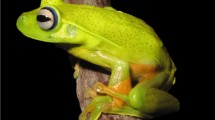Summary
Evoked potentials were recorded from the posterior dorsal thalamus of green treefrogs (Hyla cinerea) in response to single tones and combinations of two and three tones.
-
1.
The responses to two tones were largest when one of the component tones was 500 Hz and when the second component was between 2000 and 4000 Hz (Fig. 3).
-
2.
The response to 500+3000 Hz showed non-linear facilitation; i.e., the amplitude of the response was greater than the sum of the responses to the component tones alone (Figs.4, 5). This result provides evidence that cells functioning as ‘ AND ’ gates will be found in this center.
-
3.
When a third tone around 1200 Hz was added to a stimulus of 500+3000 Hz a 65% decrease in the evoked response amplitude occurred (Fig. 6).
-
4.
The largest evoked response amplitude to a two-tone stimulus (500+3000 Hz) occurred when the rise-time was less than 50 ms (Fig. 7).
-
5.
The two-tone tuning was found to be temperature dependent. The optimal lower frequency tone shifted downward with decreasing temperatures (Fig. 8).
-
6.
When the temperatures of the neurophysiological and the behavioral experiments are matched, the optimal stimuli for evoking a large response are closely correlated to the parameters of the acoustic stimuli preferred by gravidH. cinerea females in discrimination tests. This center therefore appears to be very important for the processing of complex species-specific sounds.
Similar content being viewed by others
References
Capranica RR (1966) Vocal response of the bullfrog to natural and synthetic mating calls. J Acoust Soc Am 40:1131–1139
Capranica RR (1976) Morphology and physiology of the auditory system. In: Llinás R, Precht W (eds) Frog neurobiology. Springer, Berlin Heidelberg New York, pp 551–575
Capranica RR, Moffat AJM (1980) Nonlinear properties of the peripheral auditory system of anurans. In: Popper AN, Fay RR (eds) Proceedings in life sciences, Comparative studies of hearing in vertebrates. Springer, Berlin Heidelberg New York, pp 139–165
Ehret G, Moffat AJM, Capranica RR (1983) Two-tone suppression in auditory nerve fibers of the green treefrog (Hylacinerea). J Acoust Soc Am 73:2093–2095
Frishkopf LS, Capranica RR, Goldstein MH Jr (1968) Neural coding in the bullfrog's auditory system — a teleological approach. Proc IEEE 56:969–980
Fuzessery ZM, Feng AS (1982) Frequency selectivity in the anuran auditory midbrain: single unit responses to single and multiple tone stimulation. J Comp Physiol 146:471–484
Fuzessery ZM, Feng AS (1983a) Frequency selectivity in the anuran medulla: excitatory and inhibitory tuning properties of single neurons in the dorsal medullary and superior olivary nuclei. J Comp Physiol 150:107–119
Fuzessery ZM, Feng AS (1983b) Mating call selectivity in the thalamus and midbrain of the leopard frog (Rana p. pipiens): Single and multiunit analyses. J Comp Physiol 150:333–344
Gerhardt HC (1974a) The significance of some spectral features in mating call recognition in the green treefrog (Hyla cinerea). J Exp Biol 61:229–241
Gerhardt HC (1974b) The vocalizations of some hybrid tree-frogs: acoustic and behavioral analyses. Behaviour 49:130–151
Gerhardt HC (1976) Significance of two frequency bands in long distance vocal communication in the green treefrog. Nature 261:692–694
Gerhardt HC (1978a) Mating call recognition in the green tree-frog (Hyla cinerea): the significance of some fine-temporal properties. J Exp Biol 74:59–73
Gerhardt HC (1978b) Discrimination of intermediate sounds in a synthetic call continuum by female green tree frogs. Science 199:1089–1091
Gerhardt HC (1981a) Mating call recognition in the green tree-frog (Hyla cinerea): importance of two frequency bands as a function of sound pressure level. J Comp Physiol 144:9–16
Gerhardt HC (1981b) Mating cell recognition in the barking treefrog (Hyla gratiosa): responses to synthetic calls and comparisons with the green treefrog (Hyla cinerea). J Comp Physiol 144:17–25
Gerhardt HC (1982) Sound pattern recognition in some North American treefrogs (Anura: Hylidae): implications for mate choice. Am Zool 22:581–595
Gerhardt HC (1986) Recognition of spectral patterns in the green treefrog: neurobiology and evolution. J Exp Biol 45:167–178
Gerhardt HC, Mudry KM (1980) Temperature effects on frequency preferences and mating call frequencies in the green treefrog,Hyla cinerea (Anura: Hylidae). J Comp Physiol 137:1–6
Gerhardt HC, Rheinlaender J (1982) Localization of an elevated sound source by the green treefrog. Science 217:663–664
Loftus-Hills JJ (1971) Neural correlates of acoustic behavior in the Australian bullfrogLimnodynastes dorsalis (Anura: leptodactylidae). Z Vergl Physiol 74:140–152
Moffat AJM, Capranica RR (1974) Sensory processing in the peripheral auditory system of treefrogs (Hyla). J Acoust Soc Am 55:480
Moffat AJM, Capranica RR (1976) Effects of temperature on the response properties of auditory nerve fibers in the American toad (Bufo americanus). J Acoust Soc Am 60: S80
Mudry KM, Capranica RR (1987) Correlation between auditory thalamic area evoked responses and species-specific call characteristics. I.Rana catesbeiana (Anura: Ranidae). J Comp Physiol A 160:477–489
Mudry KM, Constantine-Paton M, Capranica RR (1977) Auditory sensitivity of the diencephalon of the leopard frog (Rana p. pipiens). J Comp Physiol 114:1–13
Neary TJ, Northcutt RJ (1983) Nuclear organization of the bullfrog diencephalon. J Comp Neurol 213:262–278
Oldham RS, Gerhardt HC (1975) Behavioral isolating mechanisms of the treefrogsHyla cinerea andH. gratiosa. Copeia 1975:223–231
Walkowiak W (1980) The coding of auditory signals in the torus semicircularis of the fire-bellied toad and the grass frog: response to simple stimuli and conspecific calls. J Comp Physiol A 138:131–148
Wilczynski W, Capranica RR (1984) The auditory system of anuran amphibians. Prog Neurobiol 22:1–38
Author information
Authors and Affiliations
Rights and permissions
About this article
Cite this article
Mudry, K.M., Capranica, R.R. Correlation between auditory thalamic area evoked responses and species-specific call characteristics. J. Comp. Physiol. 161, 407–416 (1987). https://doi.org/10.1007/BF00603966
Accepted:
Issue Date:
DOI: https://doi.org/10.1007/BF00603966




